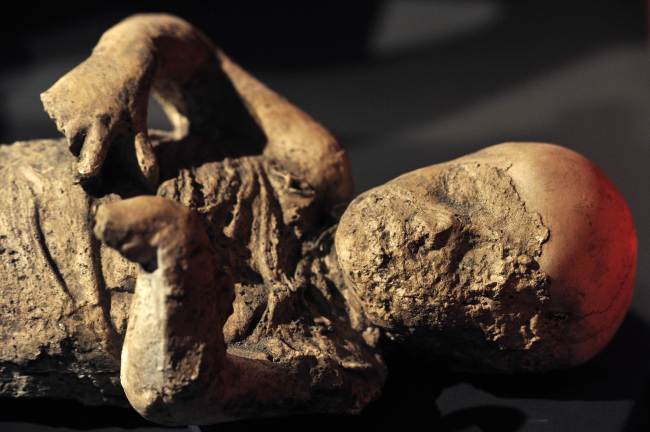LONDON (Reuters) ― An exhibition showing daily life and tragic death in the ill-fated Roman cities of Pompeii and Herculaneum opened in London on Thursday to glowing reviews and the highest advance tickets sales at the British Museum in five years.
Over 450 objects, many of which haven’t been seen outside Italy, are arranged to show everyday life in the Roman Empire before Mount Vesuvius erupted in A.D. 79, burying the two Southern Italian cities in volcanic ash.
Paul Roberts, senior curator at the British Museum, said the once bustling urban centers had been brought back to life by items such as bread left in a baker’s oven and a baby’s crib. “What we see are real people, ordinary cities,” Roberts told Reuters ahead of the opening of “Life and Death in Pompeii and Herculaneum,” the biggest Pompeii show in London for 40 years.
 |
The picture shows the cast of a child killed by extreme heat and which lies in the “pugilist” pose during the press preview for the “Life and Death Pompeii and Herculaneum” exhibition at the British Museum in central London on March 26. (AFP-Yonhap News) |
“(These are) not museum artifacts (but) possessions, things that people commissioned, bought, loved, enjoyed, used, handled.” Onions, almonds and figs were found in drains in Herculaneum while a pot of toothpicks showed the care with which the Romans looked after their teeth.
A wall painting from Pompeii pictures a baker and his wife holding writing materials, showing they are literate while their pose suggests they are equal partners, in business and in life.
Some items from the smaller, seaside town of Herculaneum were preserved in better condition, buried under hot volcanic material four times the heat of a boiling kettle. “That carbonized wood ... so the seven pieces of furniture we have from Herculaneum are the most special things we have.”
The furniture includes a linen chest, an inlaid stool, a garden bench, and a crib that still rocks on curved runners. Pompeii was discovered accidentally in the 1590s but excavations did not start until 1748.
In the 1860s archaeologist Giuseppe Fiorelli pioneered a technique of pouring plaster into the cavities left by rotted bodies. In the exhibition, casts show a family of two adults and twochildren huddled together in their final moments while another shows a dog, arched in distress before the volcano submerged the city that was home to about 15,000 people.






![[Exclusive] Hyundai Mobis eyes closer ties with BYD](http://res.heraldm.com/phpwas/restmb_idxmake.php?idx=644&simg=/content/image/2024/11/25/20241125050044_0.jpg)
![[Herald Interview] 'Trump will use tariffs as first line of defense for American manufacturing'](http://res.heraldm.com/phpwas/restmb_idxmake.php?idx=644&simg=/content/image/2024/11/26/20241126050017_0.jpg)
![[Herald Review] 'Gangnam B-Side' combines social realism with masterful suspense, performance](http://res.heraldm.com/phpwas/restmb_idxmake.php?idx=644&simg=/content/image/2024/11/25/20241125050072_0.jpg)